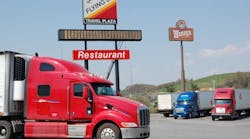A 10% annual reduction in idling is worth about 1% in fuel economy. That translates into about $500 to $700 annually at $3/gallon fuel prices and 100,000 miles/year. But given today’s driver shortage, fleets can’t just tell drivers not to idle their trucks during their mandated rest periods.
Drivers expect to be comfortable in their trucks and to be able to use things like microwave ovens, refrigerators, computers, gaming systems — all the comforts of home. However, federal, state and local ordinances prohibit idling for long periods of time, and idling can add wear and tear to the engine. This means fleets have to find other ways to make sure drivers are comfortable while resting.
As Mike Jeffress, vice president of maintenance at Maverick Transportation LLC, told us, “I don't think anyone wants to idle just to be idling; they do it because we have to provide those creature comforts.”
Our recent Confidence Report on idle-reduction technologies found that there is no one-size-fits-all when it comes to idle reduction. The good news is that fleets can choose from a number of technologies to meet their idle-reduction goals. Fleets need to weigh the benefits and challenges of each of the technologies to determine which technology makes sense for their specific operation.
The report found that the most efficient and effective idle-reduction solutions entail a combination of complementary technologies. The right combination will depend on a fleet’s routes, fuel costs, the climate in their area of operation, shop costs, maintenance costs, training methods, driver support, fleet policies, etc.
We found that the industry is having the most success by choosing one of four anchor technologies and then adding other technologies that best complement or support the anchor.
Here is what fleets told us works best:
- Driver controls + fuel-operated heater
- Diesel APU + fuel-operated heater
- Battery HVAC + fuel-operated heater
- Automatic engine start/stop system
Using these technologies along with things like setting electronic engine parameters, pre-cooling the truck prior to stopping for the day, adding extra insulation, parking in the shade, using bunk curtains, etc. means a 20% reduction in idle is not out of the question.
Use our idle-reduction report to help you choose the technologies that make the most sense for you.




